
In a country where rainfall is a far scarcer commodity than in the UK, it is heartening to see that virtually every new suburban housing development in Melbourne, Australia, now seems to incorporate some sort of water feature. These may vary from a small creek to a series of ponds to quite large lakes, often designed as part of the storm water management system. Over a period of time this reliable source of water has encouraged a new form of marine growth – the model ship builder. Exponents are lured from their surrounding habitats to small clusters on the water’s edge, where their numbers are seen to wax and wane in time with the seasons, their enthusiasm, the economy and their partners’ demands for home renovation. This is the story of one such group.
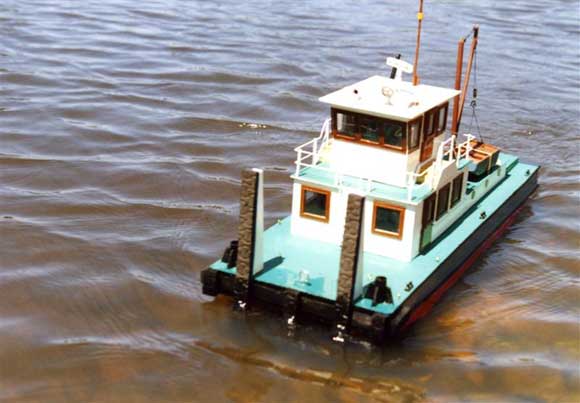

The Jack Roper Reserve
In the northern Melbourne suburb of Broadmeadows, this reserve was flooded ten years ago, forming a large blue blot on street maps of the area. Here, retired aeromodeller Stan Kurth and long-time model yachtsman Norm Skeen met on the pier that had been provided for paddlers of kayaks and wondered if the time and place might be ripe for a gathering of marine modellers and it seems it was. Once the word got around, people began to shuffle down from the car park, idly curious and hands in their pockets, but with a model boat or two salvaged from the loft in the boots of their cars. It was not long before every second Sunday in the month saw a regular group of six or seven people coming to sail their models from the pier.
Enjoy more Model Boats Magazine reading in the monthly magazine.
Click here to subscribe & save.
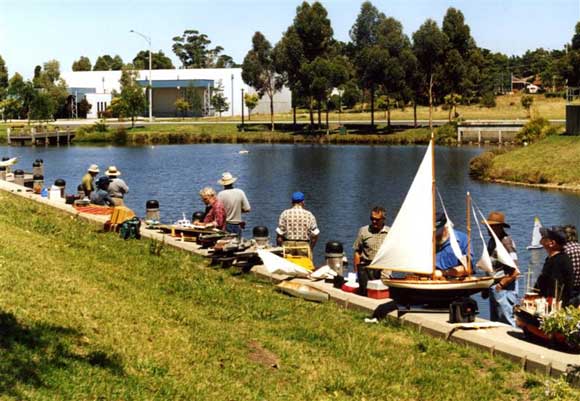
BMBG
These people call themselves the Broadmeadows Model Boat Group, (BMBG). Some have come to marine modelling from other disciplines such as aeromodelling and one such person is Peter Webster. Strictly speaking, Peter is only an honorary member of the BMBG, as he also sails with his friend Mike Gill at the rival Cairnlea Lake. Mike is pleased with his performance today around the impromptu steering course, consisting of some plastic floats anchored with house bricks. A nod from an observer confirms it – yes, he’s managed to hit every one. Well done Mike! He once had a Flower Class corvette. Alas, she now lies decaying at the bottom of Cairnlea Lake, the victim of a speed controller that jammed at full speed astern! Perhaps one day a camera equipped model submarine will plumb the depths and bring us ghostly pictures of her final resting place. Mike is more likely to be seen these days with one of his latest models, a 1956 Wavemaster or 1962 Frog High Speed Launch, Photo 1.
Peter’s Flugzeugträger Graf Zeppelin is a model of the Kriegsmarine aircraft carrier that was never completed. But what’s this? Was WWII German technology so advanced as to incorporate an early ‘ski-jump’, later made famous by HMS Invincible and her Sea Harriers? ‘Nah’, says Peter after a quick prod with his finger, ‘the plywood that I used for the deck got warped’!
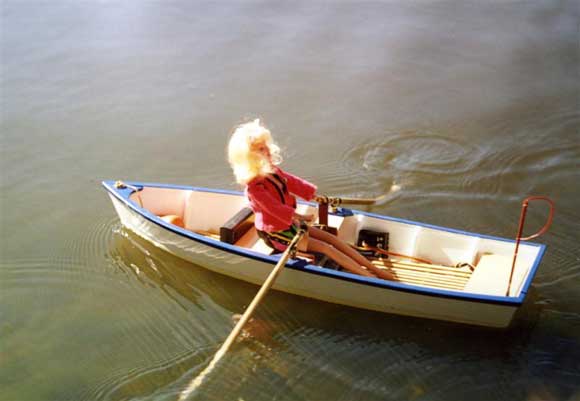
A metallurgist
Amongst the trades and professions represented in the group is that of a metallurgist, a hat worn by Bruce Henshall. Appropriately, Bruce builds his models out of metal. To be more exact, he builds them of varying thicknesses of tinplate, though it defies belief that the steep compound curves of his hulls are sculpted from steel. He finds a metal hull ideal for housing a steam plant and usually constructs such a plant along with the model. That for his Victory tug, for example is a miniature three-cylinder double-acting oscillator, 6mm bore by 11mm stroke, chosen for its ability to be self-starting and reversible by radio control.
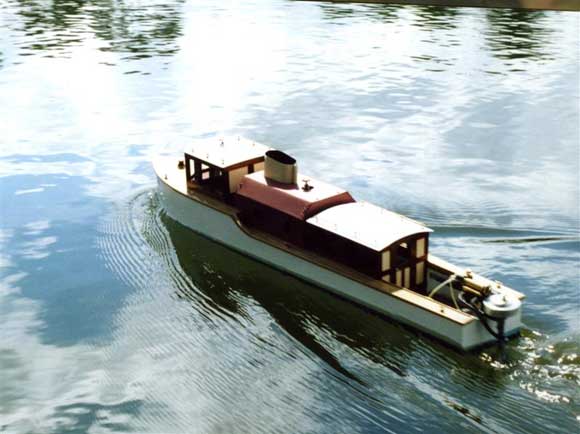
A boilermaker
Elmars Chachs has turned his hand to churning out a never ending stream of models, rarely finishing one before starting another. A specialty of Elmars is getting any form of unusual sail configuration to function effectively on a model. He has tackled such subjects as an Arabian dhow and Chinese junk. Model Boats is a popular read amongst members, especially when there is a free plan, and Elmars has recently completed a pusher tug from the February 2004 issue, Photo 2. Well endowed with cushioning blocks on all likely areas of contact, this model will hopefully prove a reliable salvage vessel for those in peril upon the waters. Salvage fees are best negotiated at the height of a disaster, Elmars recommends.

Ron Dyson – previous occupation unknown!
The Neptune 36, Photo 3, was another Model Boats plans feature, modelled this time by Ron Dyson. Ron made use of the styrene hull available for this model, but really went to town with the detailing of the superstructure, which is in 1.5mm and 2.0mm styrene sheet with mahogany trim. Unfortunately the photo does not show the delightful detail which Ron has built into this model, including the kitchen sink and neatly folded maps of Port Philip Bay stowed in the cabin. Here the captain is shown keeping a wary eye on a submarine lurking nearby.
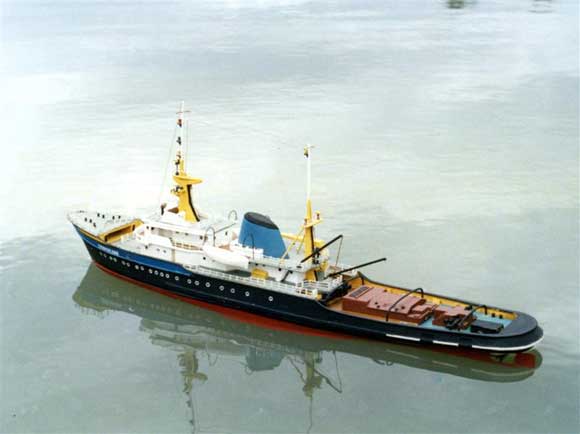
Venue change
As the size of the BMBG grew, it led to an overcrowding of the pier at the Jack Roper Reserve, a situation made worse by the proliferating bird life – right up to wide-body pelican size – whose generous deposits were beginning to make each footstep hazardous. A change of venue to the nearby lake at the Northcorp Industrial Park solved these problems and brought the advantage of a car park that was closer to the water’s edge and a retaining wall well suited for the placement of models, Photo 4.
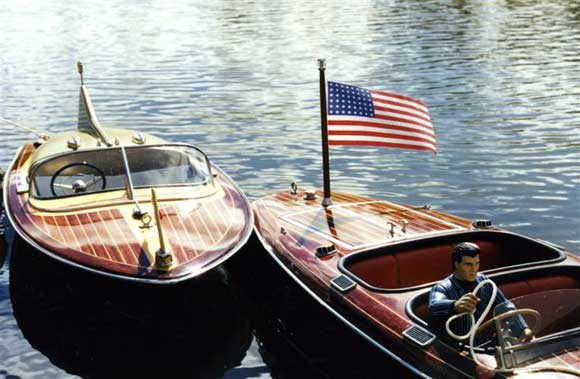
Tom Prior
One of the most prolific modellers in the group is Tom Prior, and it was very difficult to choose just two of his models to help illustrate this article. Wendy is the name of both the powerplant and boat in the case of Tom’s first model, Photo 5. She is a distant cousin of Rowley, who appeared in Radio Control Boat Modeller many years ago. Perhaps her name should have been Rowena? Wendy is a sprightly young lass with a most accomplished sculling action. It took an ingenious twin-clutch mechanism under her seat, along with painful sessions of plastic surgery and two hip replacements to enable her to achieve this. She steers by oars alone.
Tom’s other entry here was inspired by the old Bowman’s Celia May, Photo 6. He has named her Judy. There is a twist in Judy’s tail, for she is powered by a scratch-built single cylinder double acting steam engine, 8mm bore by 16mm stroke, arranged as an outboard! The crankshaft of the engine is vertical, flywheel at the top end with a flex drive to the 44mm diameter propeller at the bottom end. The arrangement works very well, the whirling flywheel and pulsating wake visible in the photo clearly demonstrating that here is a reciprocating engine at work.

Classic yachts
Warwick Gill assumed the mantle of group leader some time ago, and has a strong interest in classic yachts and wooden construction. Warwick’s models are generally scale ones, with the sort of lovely hull shapes and homely wooden cabin details whose appeal never fades. Crystal, for example, is a gaff-rigged yawl built from the original drawings of Frederick Shepherd and once described by Uffa Fox as ‘one of the best’. I suspect this was in reference to the original vessel, but the comment would apply equally well to the model. Crystal is shown setting sail on another romantic voyage of discovery, most likely to the overflow drain at the end of the lake, Photo 7!
Co-founder Stan Kurth still fields new models from time to time. Pictured is his colourful tug, the Zwarte Zee, from the early planked hull Billing’s kit, sailing in unusually calm seas, Photo 8. A more recent model is the Thornycroft torpedo boat which is about 1.2 metres long and based on information contained in an old Model Boats magazine from 1975.
By now the sun is well over the yardarm and it is time to call in the fleet. Two of my own mahogany Chris-Craft models, a Cobra (left) and Barrelback (right), jostle for a mooring at the pier, Photo 9. Ron is last on the water, taking his Neptune for just one more circuit of the lighthouse, whilst partner and friend wait patiently on the shore for his safe return, Photo 10.



